
(HBO) – Over the past years, many new health insurance policies have been issued to better serve health insurance participants. The provincial social insurance sector has coordinated with the Department of Health to organise initial medical check-ups and treatments covered by health insurance on the basis of the reality of each grassroots medical centre. Health insurance participants can register for initial medical check-up and treatment services based on the locations of their houses, as well as working and studying places.
 Health workers of the medical centre in Thuong Tien commune, Kim Boi district, the northwestern mountainous province of Hoa Binh, have outstandingly preformed their tasks of providing medical check-ups and treatments, and building trust among health insurance participants.
Health workers of the medical centre in Thuong Tien commune, Kim Boi district, the northwestern mountainous province of Hoa Binh, have outstandingly preformed their tasks of providing medical check-ups and treatments, and building trust among health insurance participants.
The inter-sectoral medical check-ups and treatments covered
by health insurance hels health insurance participants select suitable medical
centres, thus attracting more people to join health insurance.
The grant of health insurance cards to social policy
beneficiaries has been carried out in an adequate and timely manner, benefiting
over 638,000 people in 2018.
Since 2014, apart from 70 percent of State budget to
assist near-poor households in buying health insurance cards, the province has
received 20 percent from the project that aims to support near-poor households
in northeastern and Red River Delta provinces in buying health insurance cards.
Since 2018, all people of near-poor households in the province have been given
free health insurance cards.
All hospitals and medical centres in districts, city,
communes, wards and towns and private medical clinics in the province offer
medical check-ups and treatments to health insurance participants. Local
medical facilities create favourable conditions for people to get medical
check-ups and treatments covered by health insurance. Therefore, the number of
health insurance participants increased significantly over the past 10 years.
In 2009, the figure was over 531,000, making up about 67.65 percent of the
provincial population, but climbed to over 817,000 in 2018 or 96.63 percent of
the population.
All-level Party committees and authorities will
devise plans and add health insurance-related targets to their annual working
programmes and plans. They will also encourage people to join health insurance
voluntarily and regularly.
The emulation movement "Hoa Binh joining hands to build new-style rural areas” has been widely spreading, becoming a driving force that motivates the localities to renew rural landscapes and improve the material and spiritual lives of the residents. In this movement, the people play a central role-both as the main implementers and direct beneficiaries of its outcomes.
In response to the global digital revolution, Hoa Binh Newspaper is transforming itself into a modern and multi-platform media hub, blending cutting-edge technology with a restructured newsroom and a new generation of tech-savvy journalists.
Hoa Binh province’s Association of the Elderly recently held a conference to review the project on expanding the inter-generation self-help club model until 2025.
In a move to implement Resolution No. 57-NQ/TW, issued on December 22, 2024 by the Politburo, which targets breakthroughs in science-technology development, innovation, and digital transformation, the Hoa Binh provincial Department of Health has issued a plan to roll out the "Digital Literacy for All” campaign within the local health sector.
An Nghia Commune (Lạc Sơn District) is one of the communes that achieved the tha standard of the national new rural area in 2018. Entering a new development phase, the commune is now trying to meet the criteria for the advanced new rural development. With the strong political will and the public consensus, the commune is gradually overcoming the challenges to reach this goal, aiming for the sustainable development.



 Health workers of the medical centre in Thuong Tien commune, Kim Boi district, the northwestern mountainous province of Hoa Binh, have outstandingly preformed their tasks of providing medical check-ups and treatments, and building trust among health insurance participants.
Health workers of the medical centre in Thuong Tien commune, Kim Boi district, the northwestern mountainous province of Hoa Binh, have outstandingly preformed their tasks of providing medical check-ups and treatments, and building trust among health insurance participants.